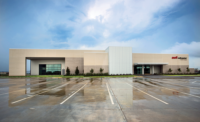GE Aviation Jet Engine Assembly Facility
Lafayette, Ind.
Best Project
Owner Pure Development
Lead Design Firm CSO Architects
Contractor Brasfield & Gorrie LLC
Civil Engineer LBYD
Structural Engineer LBYD
Much has been said about the loss of manufacturing jobs in the U.S., but the jet engine assembly facility design-built for GE Aviation by Brasfield & Gorrie is bringing 250 to 300 new manufacturing jobs to Lafayette, Ind. The state-of-the-art, $100-million facility will be used to assemble GE Aviation’s high-bypass turbofan Leading-Edge Aviation Propulsion (LEAP) engine for the biggest aircraft builders in the world, including Boeing, Airbus and jet manufacturers in China.
The 320,000-sq-ft building encloses manufacturing, assembly and collaborative office spaces, but the extremely tight tolerances required for GE’s process equipment imposed much greater demands than do most manufacturing plants. The main structure consists of a 2,500-ton steel frame that required a 370-lb column design to support the overhead gantry cranes. The LEAP engine has severely small tolerances that required the structure be designed to L/1000, allowing for little-to-no movement. The manufacturing area is a 10-in. concrete slab reinforced with welded wire, tapered plate dowels at control joints and diamond dowels at construction joints. To accommodate the process equipment’s tolerances, the slab was poured within strict flatness and levelness requirements.
Site conditions and weather also were challenging. After encountering groundwater as little as 4 ft below grade to a depth of 32 ft, extensive dewatering was required to pump more than 235 million gallons of water into an adjoining drainage basin. The main construction of the steel structure took place during extreme winter weather. Contractors worked in average temperature of 5° F; rainfalls during the project were above average. Despite these challenges, the project was completed one month ahead of schedule and under budget.
The schedule was unforgiving—the plant had to be ready on Jan. 1 to support the fast ramp into production for orders already placed. Incorporating GE’s engineers and engine technicians early in the design phase helped to reduce design changes associated with process packages and to put together a flexible design based on clear understanding of the goal. To meet critical milestones, the design-build team made the production space ready first by developing completion lists of areas affected by critical milestones to allow GE’s process contractors to work simultaneously with building trades.
The LEAP Engine Facility—just the second of its kind in the U.S.—features some of the most advanced manufacturing techniques in the world and represents a major milestone in technology development in the country, according to project officials.














